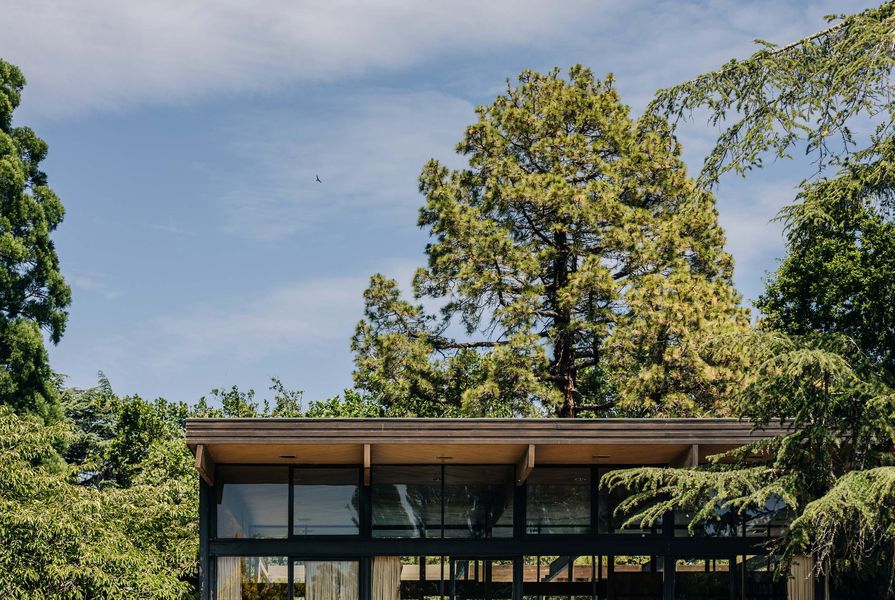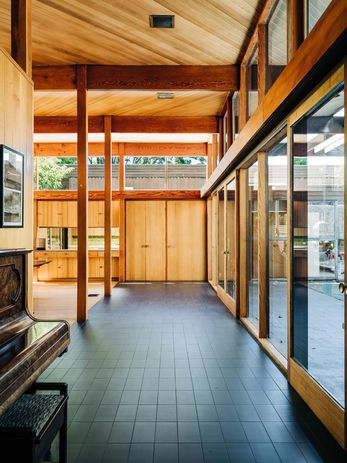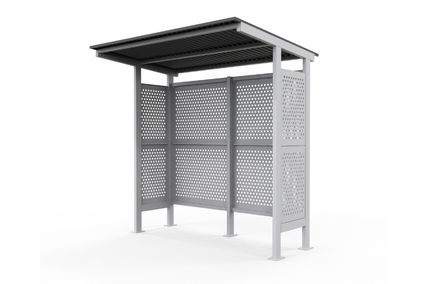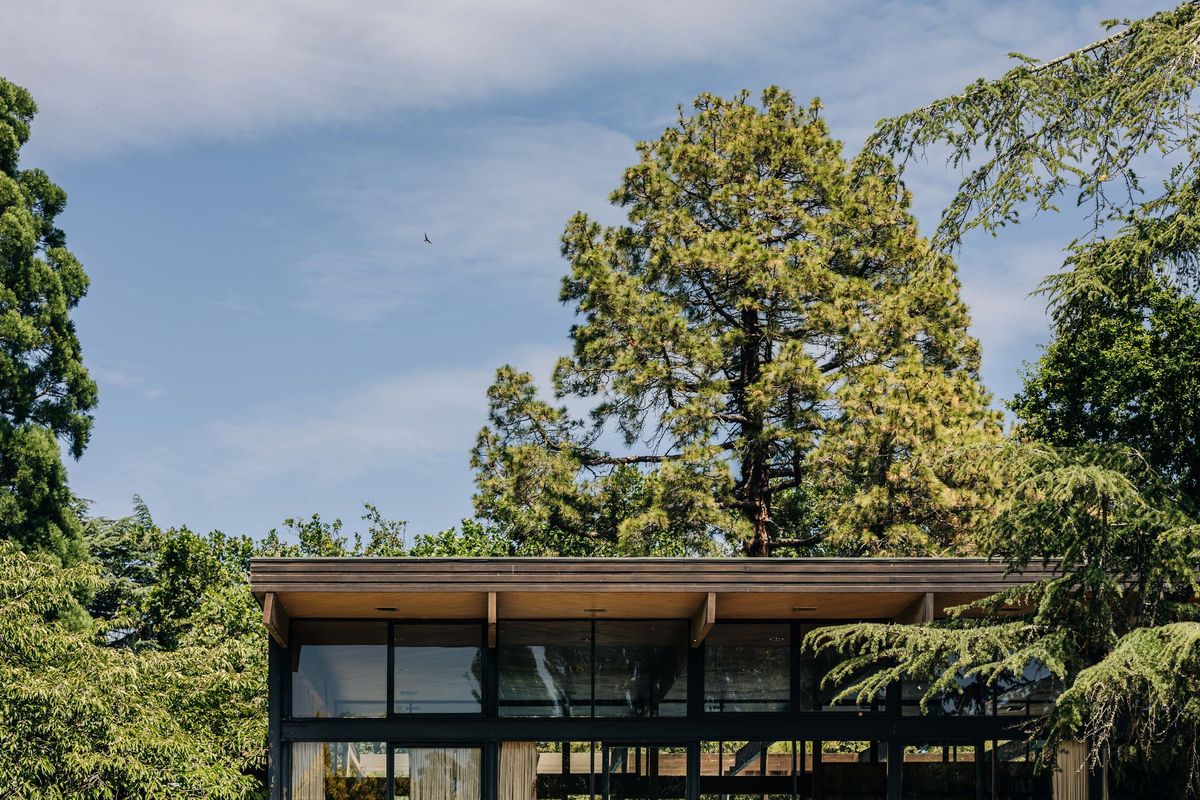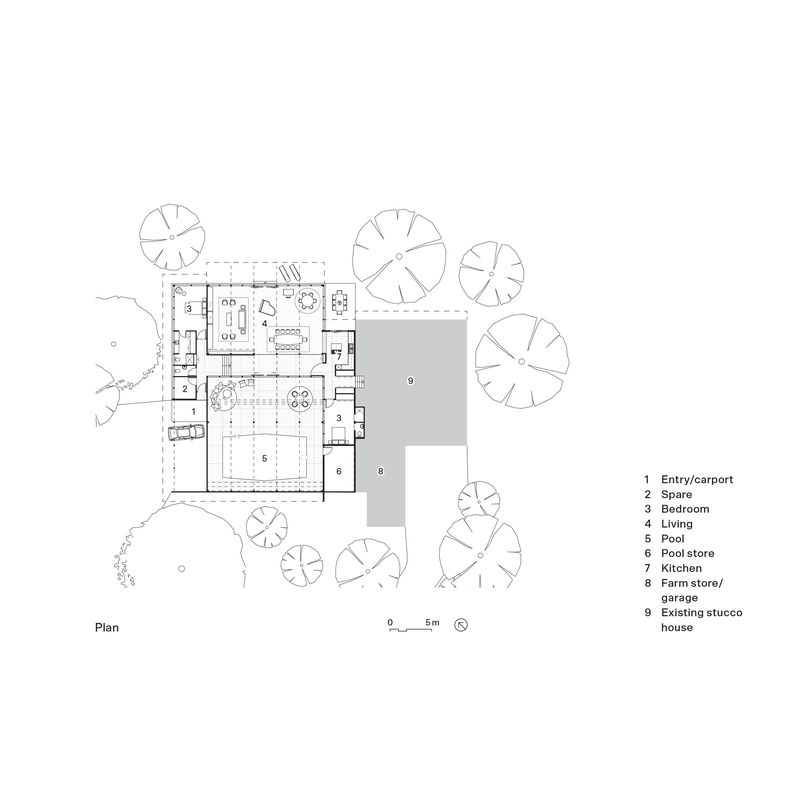In Tasmania, as elsewhere, it is well documented that splendid houses were built by pioneer settlers such as George Read (Redlands in Plenty) and Claudio Alcorso (Moorilla, now MONA). However, few know about Robin Boyd’s house, also in Plenty, on the banks of the Derwent River a short drive from Hobart.
Diana Ashbolt and her husband Anthony, a well-known Tasmanian businessman, inherited the farmhouse and its orchard from Anthony’s grandfather, Cecil Walker. When Diana first saw the red stucco farmhouse sited just 50 metres from the river, she must have been delighted. Rippling waters reflected the sun through wattles and rivergums to the house beyond. The property had been named Linden after a tree planted in the front garden.
Boyd and the original owners shared a passion for Japanese design and were inspired by the Derwent Valley’s all-timber oast houses.
Image: Adam Gibson
How Boyd was appointed for the extensive re-imagining of this new rural retreat remains a mystery, but it might have been his and the clients’ shared passion for Japanese design. The Ashbolts were both devotees of Japanese garden design and Diana was a keen ikebana student and practitioner. Boyd, meanwhile, had pursued his own interest in Japanese architecture, culminating in the publication of two small books, including one about his contemporary Kenzo Tange, architect of the 1964 Tokyo Olympic Games Stadium. Both the Ashbolts and Boyd would have been inspired by the magnificent all-timber oast houses (kilns) of the Derwent Valley, at the time among the largest all-timber structures in the Southern Hemisphere.
The project was to involve a substantial and elegant makeover of the original farmhouse. Liaising with Boyd in Melbourne, however, was always going to present a challenge, as his practice was now prolific and his academic and writing careers were blossoming.
The centrepiece of the house was conceived as a “workshop for living,” where the family’s different activities could emerge spontaneously.
Image: Adam Gibson
Diana and her husband drew up a simple brief for Boyd, requesting the conversion of the six-room farmhouse into an expansive home of new bedrooms, bathrooms, a separate guest suite, a carport, a generous pool and courtyard, and open-plan living inspired by the designs of Hobart architects Esmond Dorney and Lew Parkes, which were revolutionary at the time. They also wanted a grand room with as little in it as possible: a “workshop for living,” where the family’s different uses and activities, by day and night, could emerge spontaneously. As a talented interior and furniture designer, Diana expressed a preference for a simple material palette and a serene, all-timber interior. All this would have been conveyed to Boyd by mail prior to his visiting. One can imagine thoughtful and intense discussions with the young but already renowned architect about the emerging plans.
When Boyd finally presented his plans, Anthony and Diana must have been thrilled by his incredible display of drawings and handsome watercolour sketches. He proposed a masterful integrated composition, interpreting their needs with a magnificently scaled, multipurpose glazed pavilion 14 metres long, 11 metres wide and 4.5 metres high, reminiscent of an enlarged Japanese bungalow. It opened toward the river at the front, as they wished, and extended outward to the rear, forming a giant pergola enclosing a pool courtyard of similar proportions. This was flanked on either side by lower-scaled, single-storey structures. To the south, as Diana had foreseen, Boyd reconfigured the original stucco house as a bedroom block but, by cleverly locating the living room forward and the pool behind, he was able to place their own bedroom so that it shared the pool. To the north was the new carport, entrance and guest suite.
The open-plan living area is one of many far-sighted innovations by Boyd that have become staples of contemporary living.
Image: Adam Gibson
Given the geographic constraints, Diana was charged with project managing the construction of the house. “So out of her place on a building site,” according to her family, Diana visited regularly from Hobart to supervise the building team. Apparently, she drove the builders mad with her insistence that Boyd’s documents be faithfully followed. She ensured that works were repeated, again and again where necessary, until she was satisfied.
In parallel with overseeing the construction, Diana also planned and purchased the interior furnishings. These included a teak dining table and sideboard by Danish designer Jens Risom and a contrasting circular all-white Eero Saarinen Tulip breakfast table with six matching chairs. Located on an inspired circular grey rug with flying saucer highlights, it reflected the colours of the garden outside.
The island workbench in the intimate, low-ceilinged kitchen was inspired by the original owner.
Image: Adam Gibson
The completed house has a striking and timeless simplicity, amplified by Boyd’s sensitive interpretation of the brief and by the introduction of many far-sighted innovations that have become staples of contemporary living. These include the singularity of the open-plan living areas, with extensive floor-to-ceiling windows on both sides of the living room enabling it to “float” between pool and river, and the prominent freestanding fireplace and brass-faced chimneybreast. The generous Italian ceramic-tiled bathrooms and the delightful island workbench in the intimate, low-ceilinged kitchen were inspired by Diana.
The Linden centrepiece, now known as the Big Room, can rightly be considered a sumptuous and uniquely Australian space, and a terrific legacy for Boyd and his team and for Diana and Anthony. The project is also a testament to the Ashbolts’ foresight in the appointment of Boyd and to Diana’s inspired sense of space and materials as well as her meticulous project management.
A generous Italian ceramic-tiled bathroom was also inspired by the original owner.
Image: Adam Gibson
Today, the house is in new ownership, occupied by a family of six who took possession from the Ashbolts in June 2000. Aside from an authentic restoration following a near-disastrous fire and the planting of a new Linden tree after the original 80-year-old tree died, Linden is still remarkably intact after nearly 60 years – right down to the painting of the front door in the architect’s favoured semi-gloss forest green.
Both the former and present owners consider Linden a modern residential masterpiece and a wonderful family home – a sanctuary where their lives were, and continue to be, enriched with treasured memories.
Source
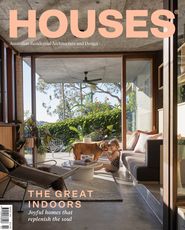
Project
Published online: 18 Jun 2021
Words:
Tim Hurburgh
Images:
Adam Gibson
Issue
Houses, April 2021

